翻译1Lecture One
lecture 1
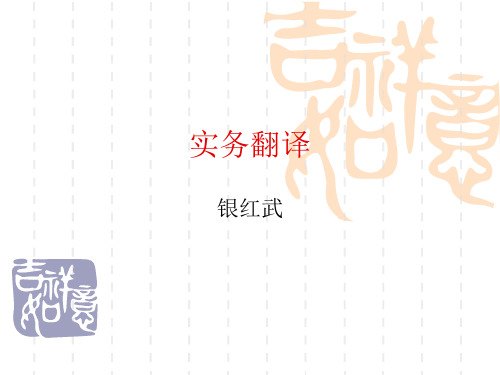
1、关于应用文本的范围
应用类文本可分为法规或成文法类应用文本 (Texts of Rules and Regulations,TRR)和对 外宣传类应用文本(Practical Texts for Foreign Recipients,PTFR)两大类,前者包括法律、合 同、政策条文等文本,后者指宣传介绍或公告类 文本及商务文本,包括各级政府新闻发布会的信 息通报、我国政治经济、文化教育等发展状况的 对外介绍、投资指南、旅游指南、城市/乡镇/企 业/公司介绍、各种大型国际性活动宣传、企业 产品/服务广告宣传、商务函电、商务单证表格 等。
4.化冗为简(形式与内容的和谐或形神结合所产生的美 感): 我们所讲的微笑,是发自内心的诚挚和善良的笑容,而 不是讨好别人的媚笑,也不是存心不良的奸笑或皮笑肉 不笑,更不是带有杀机的笑里藏刀。(“多一点微笑”) V1) What we refer to here is a sincere and goodnatured smile that comes from the bottom of one’s heart. We do not mean a smile specially put on to please others, or a false one harboring a sinister design, much less a grin with murderous intent behind. 改译:What we refer to here is a sincere and goodnatured smile, instead of a flattering one. We do not mean a sinister-harbored grin, much less a daggerhidden one.
lecture 1 汉英语言类型对比与翻译(综合语与分析语)

III. 汉语和英语的形态学分类
• 相反,作为屈折语的英语则表现为:
Hale Waihona Puke 1. 语法关系主要以词本身的形态变化予以表达,词的曲折形 态变化相对丰富,用以标示语法范畴,表达语法意义(名词 有单复数形式,形容词和副词有比较级和最高级形式,代词 有主格、宾格和所有格等形态),并集中体现在动词的时态、 体态和语态等形态变化上,形成了以动词形态变化为主轴的 句法结构模式,表意与句法形态紧密结合。 词缀变化(affixation)突出,词缀种类齐全且灵活多变,构 词法上以派生构词(derivation)为主。 词类分明,结构形式严谨,语法和逻辑意义的表达呈显性 (overt) ,结构上主要遵循形式一致性原则,表现为形式和 意义的基本对应。
IV. 形态学分类视角下的汉英互译
以上对比分析表明,汉语和英语在表意手段上,前者以词汇 手段为主,后者以形态手段为主,汉英互译时就要充分发挥 译语优势,选用符合译语(target language)语言习惯的表 意手段,灵活变通,兼容互补,恰当再现源语(source language)的语法和逻辑意义。例如: 1. I was a modest, good-humored boy; it is Oxford that has made me insufferable. 【原译】我本来是一个谦虚谨慎、人见人爱的孩子,是牛津 大学将我弄得这么人见人嫌。 【试译】我原本谦逊尔雅、人见人爱,是牛津大学教得我人 见人嫌。
II. Important Concepts
• For example, the generation of the English plural dogs from dog is an inflectional rule, while compound phrases and words like dog catcher or dishwasher are examples of word formation. • Informally, word formation rules form "new" words, while inflection rules yield variant forms of the "same" word, which may be different in grammatical sense. • Accordingly, morphology is generally divided into two fields: inflectional morphology and derivational morphology. And There is a further distinction between two types of word formation: derivation and compounding.
lecture 1 翻译标准

g. 我认为他不够格。 I don’t think he is qualified. h. 人们来五台山,目的可不都是一样。 People do not come to Wutai Mountain with one and the same purpose.
3) 译文应体现英语遣词造句的特点,同时 又应因文体而有变化。 a. 名词使用频率高,特别是含有动作性质 的抽象名词等,可以既包含丰富的信息又 十分简洁。 b. 被动形式使用率高,表现能力强。 c. 语法要求严,一般来说句子较长。 d. 介词、非谓语动词、形容词和独立结构 非常活跃。
教心理学的老师觉察到这件事, 就假冒一个男生的名义,给她 写了封匿名的求爱信,这封信 的末尾是:一个希望得到您的 青睐的极其善良的男同胞。就 这么一封信,也就一举改造了 一个人。
Having detected what was happening, her psychology teacher got an idea. In the name of a boy, he wrote an anonymous letter of love which ended with “a kind gentleman awaiting your favor.” The letter brought about transformation.
A Course in Chinese – English Translation
李洋
II. 汉英翻译的原则
汉语译成地道英语的难度, 出现各种各样的缺失:“中 国式”英语(解决办法,阅 读大量原作,观察、揣摩、 总结并模仿英语的特点、规 律和表达方法)。
1.遵循三条原则:
1) 译文必须符合英语的语法:三种轴心 结构: a. 主-系-表结构 (S+V+P) 例: a) 人类在地球上已存在多久了? How long has man been on earth? b) 牛奶变酸了。 Milk turns sour.
Lecture 3 翻译的标准

Lecture 3 翻译的标准翻译标准:目前翻译界普遍接受的,也是作为一般翻译学习者必须努力掌握的标准,简而言之是两条:忠实(Faithfulness) 和流畅(Smoothness)。
外语腔是初学翻译者不知不觉地会在汉语译文中表现出来的一种不当倾向。
翻译时所要表达的内容来自外语原文,原文的词语和结构形式随着内容一起进入到我们的大脑,于是原文的语言形式被带入译文,造成了译文的外语腔。
The only concession he made to the climate was to wear a white dinner jacket.【译文】气候变化,他仅稍稍作了一点变通,赴宴时穿了件白色的短礼服。
翻译标准:忠实和流畅好的译文还必须保持原文的风格包括民族风格、时代风格、语体风格、作者个人的语言风格等。
即:译者不能破坏或改变原文的风格,不能以译者的风格代替原作的风格。
课堂练习:•She couldn't have come at a better time.•She has been a widow only six months.•I believe the speech was needlessly stubborn.•The Englishman feels no less deeply than any other nationality.•From a physical standpoint, there ought to be as many colours as there are different wave lengths.•As a human being, we should demonstrate our intellectual and moral superiority by respecting others for who they are -- instead of rejecting them for who/what they are not.1. 她来得正是时候。
英语翻译
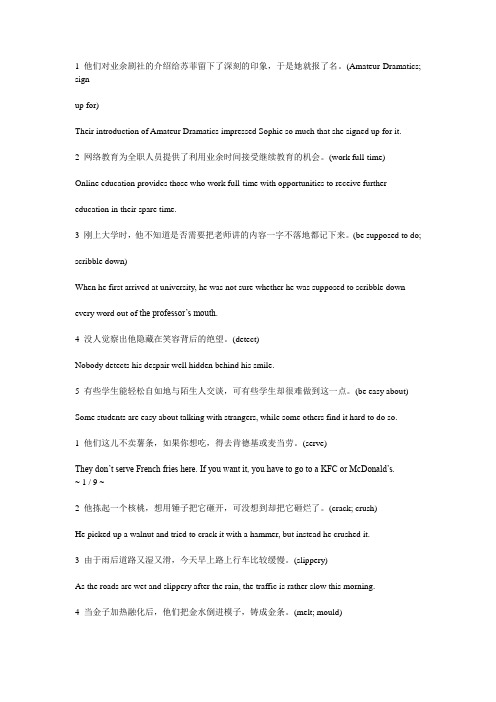
1 他们对业余剧社的介绍给苏菲留下了深刻的印象,于是她就报了名。
(Amateur Dramatics; signup for)Their introduction of Amateur Dramatics impressed Sophie so much that she signed up for it.2 网络教育为全职人员提供了利用业余时间接受继续教育的机会。
(work full-time)Online education provides those who work full-time with opportunities to receive furthereducation in their spare time.3 刚上大学时,他不知道是否需要把老师讲的内容一字不落地都记下来。
(be supposed to do;scribble down)When he first arrived at university, he was not sure whether he was supposed to scribble downevery word out of the professor’s mouth.4 没人觉察出他隐藏在笑容背后的绝望。
(detect)Nobody detects his despair well hidden behind his smile.5 有些学生能轻松自如地与陌生人交谈,可有些学生却很难做到这一点。
(be easy about)Some students are easy about talking with strangers, while some others find it hard to do so.1 他们这儿不卖薯条,如果你想吃,得去肯德基或麦当劳。
(serve)They don’t serve French fries here. If you want it, you have to go to a KFC or McDonald’s.~ 1 / 9 ~2 他拣起一个核桃,想用锤子把它砸开,可没想到却把它砸烂了。
Lecture 1 汉英语言对比与翻译(工硕)

1.1 分析语vs.综合-分析语
汉语 英语
Analytic 分析语
通过虚 词、词 序等手 段来表 达语法 关系
通过词
Synthetic- 本身的
analytic 形态变
综合-分析贝拉· 比顿曾在其著作的一个早期版本 里说过:“受用一顿美餐,能使 整个上午工作精力充沛。”这番 高见,现在很少有人领教了。
Potential Unit 12 The City
参考答案及译文下载:
/d115238389.htm
考试: 1. 课程考试 每学期一次
题型: 词汇30% 完型15% 阅读20% 英汉互译 (10+10)% 写作15%
所学内容占85%
2. 学位考试 每年5月和10月举行一次
她们妯娌吵嘴, 不巧被我撞见了。
I chanced to be present when the sistersin-law were having a quarrel.
1.3具体vs.抽象
以实的形
Concrete 式表达虚
汉 具体
的概念,
语
以具体的
形象表达
抽象的内
容
Abstract 英 抽象 语
“就来!”她转 身脚不沾地地越 过草坪, 跑上 小道,踏上台阶, 穿过阳台,走进 门厅。
“Coming!” Away she skimmed over the lawn, up the path, up the steps, across the veranda, and into the porch.
1.2 意合vs.形合
词语或语
Parataxis 句间的连
汉 意合
接主要凭
语
借语义或
翻译练习

翻译练习:1.有的地方热衷于搞华而不实的“形象工程”,“政绩工程”,市政建设盲目追求高档次,高标准。
(朱镕基)Some local authorities like to build ostentatious projects in order to make a good impression or show their achievements. In urban development, they indiscriminately pursue things of the highest grade or standard.2.本书精选中国南方26个少数民族的131则脍炙人口的故事。
The book consists of 131 superb stories popular among 26 minority nationalities in the south of China.3.德国相机的主要特点是工艺精湛,经久耐用。
The German cameras are chiefly characterized by their fine workmanship and durability.4.听人家背地里议论,孔乙己原来也读过书,但终于没有进学,又不会营生;于是愈过愈穷,弄到要讨饭了。
From the gossip that I heard, it seemed that Kong Yiji had studied the classics but never passed the official examinations and, not knowing any way to make a living, he had grown steadily poorer until he was almost reduced to beggary.5.女的一叉腰:“我就这么蛮,你怎么着?当初怎么不把眼睛睁大点!怎么啦,后悔啦,又想起先前的小情人了吧……”话音未落,男的一扬手,“呼”的一巴掌甩过去。
lecture 1翻译概述

Christiane Nord
• ―Translation is the production of a functional target text maintaining a relationship with a given source text that is specified according to the intended or demanded function of the target text.‖
Cambridge Encyclopedia of Language
― It is sometimes said that there is no
task more complex than translation --- a claim that can be readily believed when all the variables involved are taken into account. Translators not only need to know their source language well; they must also have a thorough understanding of the field of knowledge covered by the source text, and of any
Peter Newmark
• Translation is a craft consisting in the attempt to replace a written message and/or statement in one language by the same message and/or statement in another language. • (Translating) is rendering the meaning of a text into another language in the way the author intended the text.
英语翻译理论与技巧二--翻译的基本问题xzb
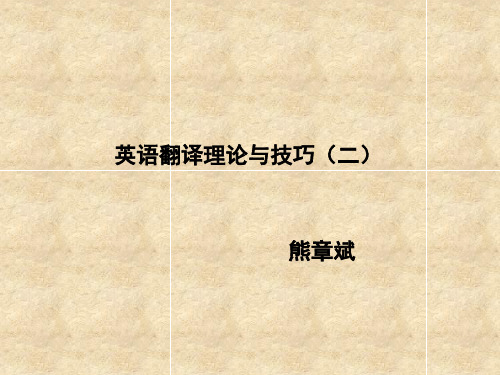
基本标准:忠实而通顺 所谓忠实,首先指忠实于原文的内容。译者必须把原作的内容完整、准确地表 达出来,不得改变、歪曲、遗漏或增加。忠实还指保持原作的风格——民族风 格、语体风格、作者个人的语言风格。对这些风格,译者不得任意破坏和改变, 不能以译者的风格代替原作的风格。原作如果是通俗的口语体,译文不能译成 文皱皱的书面体;原作是文雅的,译文不能是粗俗的;原文富有西方色彩,译 文不能冠以东方色彩。反之亦然。 所谓通顺,指译文语言必须通顺易懂,符合规范。译文必须是明白、流畅的, 而不应该是晦涩拗口的。译文中不得有文理不通,逻辑混乱的现象。但须指出, 译文的通顺程度要和原文的通顺程度相应或一致。例如在文艺作品中,作者有 时故意采用一些非规范语言以刻画人物或渲染气氛,译文就不能片面追求通顺 而加以改变,应尽可能体现原作的语言特征或风格,这正是忠实的具体体现。 忠实与通顺是相辅相成的。忠而不顺,读者读不懂,也就谈不上忠;顺而不忠, 丢失原作风格与内容,通顺也就失去了作用,使翻译成了编译或乱译。忠实是
in terms of style.”
2.翻译的标准 翻译标准,是翻译活动所必须遵循的准绳 ,是衡量译文 质量的尺度,是翻译工作者不断努力以期达到的目标。 要确立翻译标准,首先必须分析翻译的对象,即原作。 原作包括两个方面:内容与形式。内容指原作中所叙述 的事实,说明的事理,描写的人、物,以及所反映出来 的作者的思想、感情、态度、观点和立场。形式指语言 形式,即作者所使用的词汇、语法、修辞手段等的总和。 内容和形式是相互联系、相互制约的。内容决定形式, 形式影响内容。
3.翻译的过程 3.1 原文的理解 3.2 语言的表达
3.1 原文的理解 1.语义的理解
Example:
1.We eat what we can and what we can’t we can. 能吃的我们就吃,不能吃的我们就做成罐头。
Lecture 1-2 词汇对比

do large harm to do great harm to
great population
a large population crowded traffic heavy traffic
keep one’s face save one’s face
留面子
三、 情感意义对比
教师休息室 teachers’ restroom
sea cucumber 海黄瓜
海参
不能望文生义,要勤查 字典,避免貌合神离
4. Mr. Smith is one of the most durable teachers at this university. 持久的 史密斯先生是该大学任教时间最长的教师之一. 5. He used to be very shy; but after entering college he’s started to blossom. 开花、绽放 他过去一直非常害羞,但是现在他开始活泼/开朗起来。
译文一:…… made our blood boil. 愤怒 译文二:Beijing's winning the bid for the 2008 Olympics ek 凉茶 红茶 cold tea red tea
yoghurt herbal tea black tea teachers’ lounge
3. 意见 (1) 我们应该认真倾听群众的意见。
看法
We should listen carefully to people’s opinions. (2) 两位领导人就双边关系及共同关心的问题交换了意见。 见解 (fml) The two leaders exchanged views on bilateral relations and issues of common concern.
新视野大学英语第一册课后翻译题及答案(1-7unit)
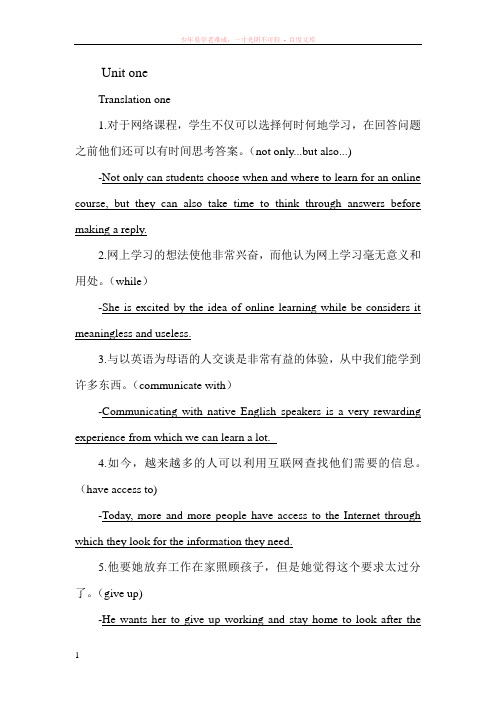
Unit oneTranslation one1.对于网络课程,学生不仅可以选择何时何地学习,在回答问题之前他们还可以有时间思考答案。
(not only...but also...)-Not only can students choose when and where to learn for an online-Today, more and more people have access to the Internet through which they look for the information they need.5.他要她放弃工作在家照顾孩子,但是她觉得这个要求太过分了。
(give up)-He wants her to give up working and stay home to look after thechildren. She feels, however, that this is too much for her.6.既然我们已经学完这门课程,就应该多做些复习。
(now that)-Now that we have finished the course, we shall start doing more revision work.Translation Twofriend.-写作不仅仅要写老师布置的话题,而且要写自己感兴趣的东西,例如,给朋友写电子邮件。
4.Distance learning courses are courses in which the instructor communicates with students using computer technology.-远程教学课程是指授课者与学生通过计算机通信技术进行交流的课程。
5.English is not only the most useful language in the world,but it is also one of the easiest languages to learn and to use.-英语不但是世界上最有用的语言,也是世界上最易学、易用的room and shouted at her, “Can’t you turn down the music a little bit?”2.酒吧的老板一直在看那个女孩跳舞,一面却假装没在看。
Lecture 1 语用学与翻译 ppt课件

4
Leech 的礼貌原则
得体准则,最小限度地让别人吃亏,最大限度的使别 人受益
宽宏准则:最小限度地使自己受益,最大限度地让自 己吃亏
褒扬原则; 最小限度地贬低别人,最大限度地赞誉别 人
谦虚原则:最小限度地赞誉自己,最大限度地贬低自 己
一致准则:尽量缩小自己与他人的分歧,尽量加大自 己与别人的一致
同情准则:尽量缩小自己对他人的厌恶,尽量加大自
客观 环境因素称为“言外语境”。言外语境又可分为情景 语境和社会文化语境两类。
(1) 翻译表达应充分考虑译语言内语境,表达应 符合译语习惯。
eg:“Shall we meet on the first floor of the
restaurant?
在英国,first floor在楼层的序列中排在ground
己对他人的同情
PPT课件
5
在双语交际中仅运用一种原则是不合适的,因为不同 社会的语用原则是不同的。中国文化特别强调谦逊准则, 而英美人更注重质量准则。
如中国人特别重视甚至过于强调谦逊原则,当受到 表扬时,往往谦虚一番:“哪里,哪里”;“不,做得很不 够”;受到表扬时如果不谦逊一番,很可能被认为“骄傲 自满”。而在以英语为母语的西方国家,人们接受表扬时 会微笑地说声:“Thank you!”倘若不懂得这两种不同的 礼貌方式,翻译就会生硬别扭。
语用学与翻译
PPT课件
1
第一讲 语用学
PPT课件
2
语用学的定义
语用学是语言学各分支中一个以语言意义
为研究对象的新兴学科领域,在众多的语用学 定义中,有两个概念是十分基本的,一个是意 义,另一个是语境,是专门研究语言的理解和 使用的学问,它研究在特定情景中的特定话语, 研究如何通过语境来理解和使用语言。
Lecture 1-8(中英句子)
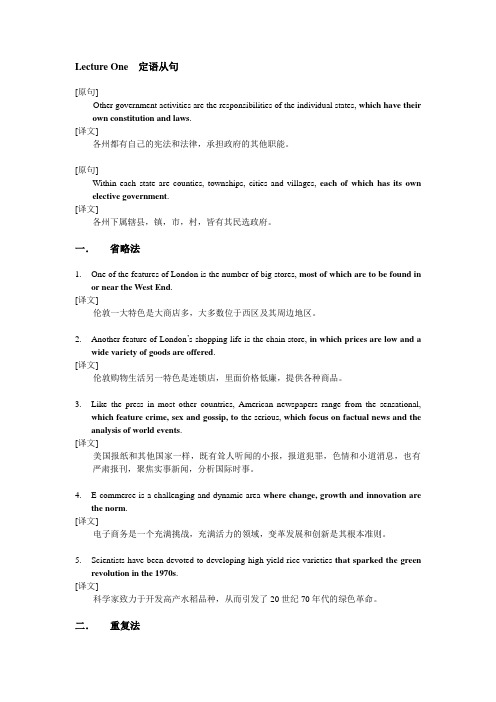
Lecture One 定语从句[原句]Other government activities are the responsibilities of the individual states, which have their own constitution and laws.[译文]各州都有自己的宪法和法律,承担政府的其他职能。
[原句]Within each state are counties, townships, cities and villages, each of which has its own elective government.[译文]各州下属辖县,镇,市,村,皆有其民选政府。
一.省略法1.One of the features of London is the number of big stores, most of which are to be found inor near the W est End.[译文]伦敦一大特色是大商店多,大多数位于西区及其周边地区。
2.Another feature of London’s shopping life is the chain store, in which prices are low and awide variety of goods are offered.[译文]伦敦购物生活另一特色是连锁店,里面价格低廉,提供各种商品。
3.Like the press in most other countries, American newspapers range from the sensational,which feature crime, sex and gossip, to the serious, which focus on factual news and the analysis of world events.[译文]美国报纸和其他国家一样,既有耸人听闻的小报,报道犯罪,色情和小道消息,也有严肃报刊,聚焦实事新闻,分析国际时事。
英汉互译Lecture 1 (2)

General principle
• Translate literally, if possible, or appeal to free translation.
• 1)For Kino and Juana, this was the meaning of morning of their lives, comparable only to the day when the baby had been born. Literal translation: 在Kino和Juana看来,这 是他们一生中最了不起的早晨,只有宝宝 出生的那一天,才可以与之媲美. Free translation: Kino和Juana认为,这一天 非常重要.
More
• 1) It was an old and ragged moon. 是一个又老 又破的月亮. • 2) Many of his ideas are especially interesting to modern youth. Word-for-word translation: 他的许多思想 对当代青年特别有趣. • 3)Being a teacher is being present at the creation, when the clay begin to breathe. Word-for-word translation: 老师一直在创 造中,当泥土开始呼吸。
Difference between word-for-word translation and literal translation
• Word-for-word translation: translate word by word without making any adjustment, starchy, stiff, unintelligible (死板、生硬、 难理解) • unacceptable, unqualified translation • Literal translation: make some necessary adjustment; smooth, clear & natural. Can have almost the same feeling as the SLR. • Acceptable, good translation
英语专业翻译【课件】

英汉对比与翻译: 1.包惠南、包昂《中国文化与汉英翻译》,外文2004. 2.陈定安《英汉比较与翻译》,中国对外翻译2006. 3.陈文伯《英汉成语对比与翻译》,世界知识2005. 4.何善芬《英汉语言对比研究》,上海外教社2002. 5.金惠康《跨文化交际翻译》,中国对外翻译2005. 6.李定坤《汉英辞格对比与翻译》,华中师大1994. 7.连淑能《英汉对比研究》,高等教育1993. 8.刘宓庆《新编汉英对比与翻译》,中国对外翻译2006. 9.潘文国《汉英语对比纲要》,北京语言大学2004. 10.彭宣维《英汉语篇综合对比》,上海外教社2000. 11.王德春《汉英谚语与文化》,上海外教社2001. 12.王菊泉、郑立信主编《英汉语言文化对比研究(1995-2003)》,上海外教社2004. 13.汪福祥《英美文化与英汉翻译》,外文2006. 14.王逢鑫《英汉比较语义学》,外文2001. 15.魏志成《英汉语比较导论》,上海外教社2003. 16.萧立明《英汉比较研究与翻译》,上海外教社2002. 17.熊文华,《汉英应用对比概论》,北京语言大学,1997. 18.杨丰宁《英汉语言比较与翻译》,天津大学2006. 19.张良军、王庆华、王蕾《实用英汉语言对比教程》,黑龙江人民2006. 20.赵世开主编《汉英对比语法论集》,上海外教社1999. 21.周志培《汉英对比与翻译中的转换》,华东理工2003. 22.朱永生、郑立信、苗兴伟《英汉语篇衔接手段对比研究》,上海外教社2001.
Hale Waihona Puke Lecture 1 Introduction
1.What is translation? 2.What is the function of translation? 3.Translation standards? 4.Translation methods? 5.The purposes of translation?
高中英语大全:英汉翻译与词汇对应的问题
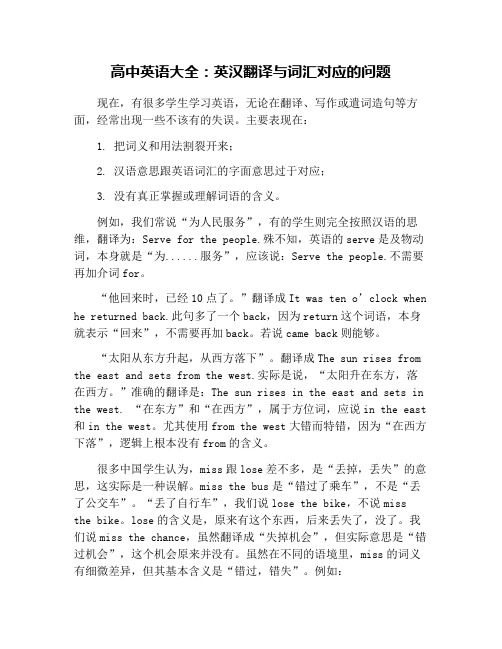
高中英语大全:英汉翻译与词汇对应的问题现在,有很多学生学习英语,无论在翻译、写作或遣词造句等方面,经常出现一些不该有的失误。
主要表现在:1. 把词义和用法割裂开来;2. 汉语意思跟英语词汇的字面意思过于对应;3. 没有真正掌握或理解词语的含义。
例如,我们常说“为人民服务”,有的学生则完全按照汉语的思维,翻译为:Serve for the people.殊不知,英语的serve是及物动词,本身就是“为......服务”,应该说:Serve the people.不需要再加介词for。
“他回来时,已经10点了。
”翻译成It was ten o’clock when he returned back.此句多了一个back,因为return这个词语,本身就表示“回来”,不需要再加back。
若说came back则能够。
“太阳从东方升起,从西方落下”。
翻译成The sun rises from the east and sets from the west.实际是说,“太阳升在东方,落在西方。
”准确的翻译是:The sun rises in the east and sets in the west. “在东方”和“在西方”,属于方位词,应说in the east 和in the west。
尤其使用from the west大错而特错,因为“在西方下落”,逻辑上根本没有from的含义。
很多中国学生认为,miss跟lose差不多,是“丢掉,丢失”的意思,这实际是一种误解。
miss the bus是“错过了乘车”,不是“丢了公交车”。
“丢了自行车”,我们说lose the bike,不说missthe bike。
lose的含义是,原来有这个东西,后来丢失了,没了。
我们说miss the chance,虽然翻译成“失掉机会”,但实际意思是“错过机会”,这个机会原来并没有。
虽然在不同的语境里,miss的词义有细微差异,但其基本含义是“错过,错失”。
Business English Translation Introduction to the Course 商务英语翻译课件
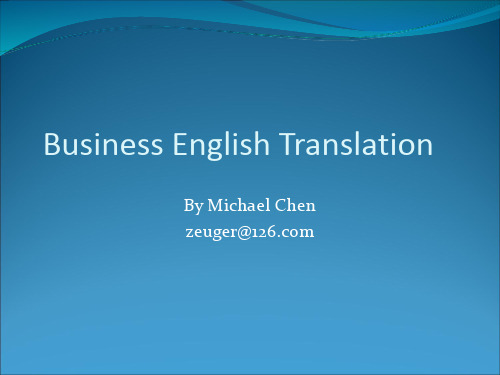
been replaced by the other one. ---the purpose of translation is to translate the
Chapter One
Lecture One Basic Theories of Translation
1. Definition
• 1)《辞海》:把一种语言文字的意义用另一种语言文 字表达出来
• 2) Oxford: to turn from one language into another • 3) Translation is the replacement of textual material
翻译,是指在译语中用最切近而又自然的对等 语再现原语的信息,首先在语义上,其次是文体 上。
• 5)翻译是运用一种语言把另一种语言所表达的思 维内容准确而完整地重新表达出来的语言活动 ----张培基
The core of definition:
---translation is a behavior or process ---translation involves two kinds of languages or two
• When there are great differences between source language and target language in the sequence of vocabulary, grammatical structure and artistic devices, liberal translation should be employed.
lecture1专业英语的特点

构造材料的强度越来越高,目的就是满足不断增长的现代工业需求。
(2) What does a furnace do? It heat-up a material. The function of a furnace is to heat-up a material.
Let A be equal to B.设A等于B。 Consider a high-pressure chambeammar Features
(5) 复杂长句使用频繁〔准确、精炼〕
为了完整、准确地表达事物内在联系,使用大量从句
It has been mentioned above that the electrons in a metal are able to move freely through the metal, that their motion constitutes an electric current in the metal and that they play an important part in conduction of heat.
图1所示喷气发动机横截面举例说明了金属材料在大量严苛条件下的应用。
1.3 Grammar Features
2) The term “structure〞, as it was pointed out above, means the arrangement of a material’s atoms.
中心是客观现象及事物本身,而非动作的发出者,把论证说明的对象
- 1、下载文档前请自行甄别文档内容的完整性,平台不提供额外的编辑、内容补充、找答案等附加服务。
- 2、"仅部分预览"的文档,不可在线预览部分如存在完整性等问题,可反馈申请退款(可完整预览的文档不适用该条件!)。
- 3、如文档侵犯您的权益,请联系客服反馈,我们会尽快为您处理(人工客服工作时间:9:00-18:30)。
翻译1Lecture One
11
Our Focus
1. Translation Practice 2. Contrast Study between English and
Chinese 3. An Overview of Translation Theory in
China and abroad
翻译1Lecture One
12
Ⅱ. A Brief Survey to Chinese Translation History(5 peaks)
1. Religious translation (3 phases)
A. Early stage (East Han—Sui Dynasty): near 570 Buddhist scriptures, foreigners as major translators.(安世高, 支谶,支谦,竺法护)
--《新编大学英译汉教程》,华先发,上海外语教育出版社,2004 – 《英汉翻译教程》,张培基,上海外语教育出版社,1980 – 《实用翻译教程》,范仲英,外语教育与研究出版社,1994 – 《中国翻译简史》,马祖毅,中国对外翻译出版公司,1998 – 《中国译学理论史稿》,陈福康,上海外语教育出版社,2000 – 《英汉对比研究》,连淑能,高等教育出版社,1993 – 《西方翻译简史》,谭载喜,商务印书馆,2004
翻译1Lecture One
3
Teaching Plan:
1.总论 (4课时) • 翻译的定义,性质和分类 • 翻译的标准和原则 • 翻译过程 • 翻译史简介
翻译1Lecture One
4
2.英汉语言的对比(8课时) • 形合与意合 • 聚集与流散 • 抽象与具体 • 间接与直接 • 主动与被动 • 人称与物称
– Translation Studies, Bassnett, Susan. Shanghai Foreign Language Education Press,2004(Chapter 2)
翻译1Lecture One
2
• Demand:
– Attention – Active – Attitude
B. Middle stage(East Jin--- Sui Dynasty):3155 Buddhist scriptures,cooperation of foreigners and natives.(鸠摩罗什 ,道安,慧远,彦琮)
C. Later stage(Early --- Mid-Tang Dynasty): the peak of religious translation with natives as major translators.(玄奘)
翻译1Lecture One
5
3.英译汉常用方法与技巧(16课时) • 1. 直译,意译与音译 • 2.词义的选择,引申与褒贬 • 3.词性转换 • 4. 增补 • 5. 省略 • 6. 重复 • 7. 肯定与否定
•
翻译1Lecture One
6
4.句子的翻译 (12课时) • 1.名词性从句 • 2.状语从句 • 3.定语从句 • 4.长句
翻译1Lecture One
7
• 5. 习语的翻译 (2课时) • 6. 颜色词的翻译(2课时) • 7. 英语修辞的翻译(4课时)
翻译1Lecture One
8
Teaching Model
1. Teacher (framework) 2. Group Discussion(difficulties) 3. Individual Performance(practice ) 4. Extensive Reading(history and theories)
翻译1Lecture One
9
Introduction
Ⅰ.Domains of translation studies • Internal study(core) (1) Theoretical framework (2) Nature, principles, criteria of translation (3) Translatability (4) Translation methods and skills (5) Art and style (6) Translated texts (7) . (8) . (9) .
翻译1Lecture One
10
2. Eternal study (1) Relationship between translation and other disciplines
such as philosophy, sociology, culturology, linguistics, psychology, literature, computer science and so on. (2) Translation teaching (3) Translation criticism (4) Translators competence and training (5) Translation text books and reference books (6) Communication with oversea organizations (7) . (8) . (9) .
• Evaluation:
– Class participation, 5%; Class discussion, 5%; Homework & research, 40%
– Final examination, 50% (if there will be no exam, homework & res. will take 90%)
Translation Theory and Practice
Roger ,翻译1Lect Nhomakorabeare One
1
Course Description
• Purpose:
basic ideas,basic skills, general survey, translation ability
• Textbook and references (books to read):
